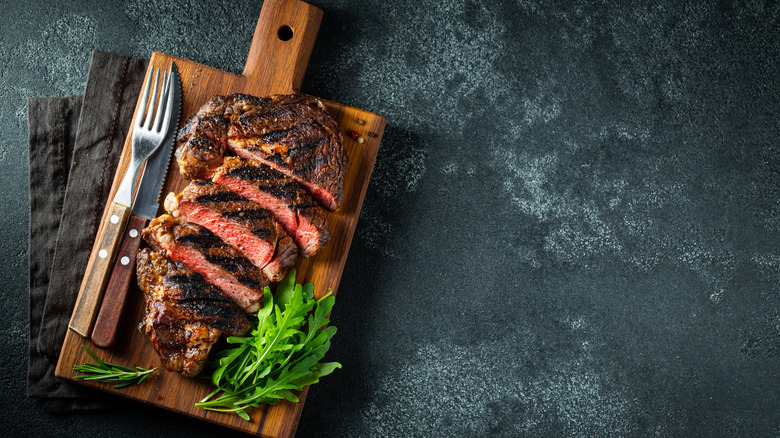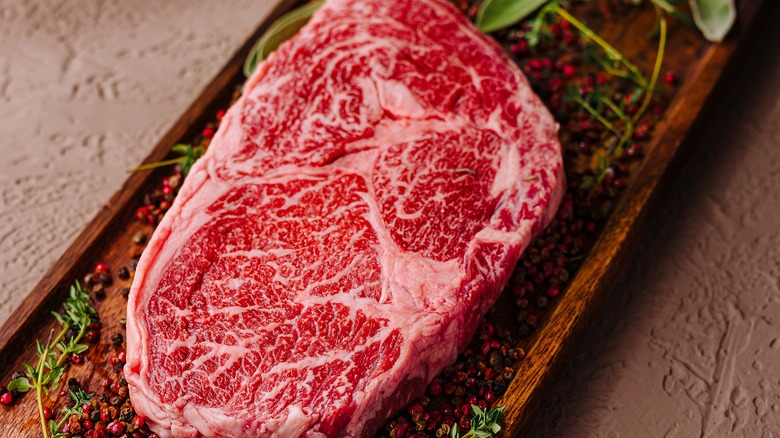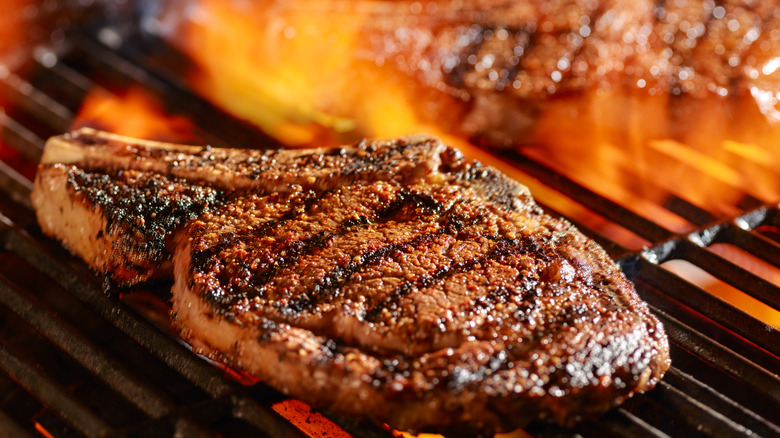Here's Why Ribeye Is The Best Steak To Throw On Your Grill This Summer
The summertime months mean breaking out the grill and firing it up, and there are few better things than tending that grill and ending up with a perfectly cooked steak at the end of things. Some steaks are better for grilling than others, and one of the very best is a ribeye.
Why is this steak one that comes out so famously flavorful when it's cooked on the grill? A large part of what makes ribeye the go-to for grilling is the tendency for this cut to come with the perfect amount of marbling. The fat that runs through a steak serves a few different purposes, including making it juicy and keeping in tender. The ribeye has just enough but not too much, and it means that the meat that makes it to the plate is downright delectable.
That starts with choosing the right ribeye, though. Look for one that has visible marbling throughout, and that marbling should be white (or, in the case of grass-fed beef, slightly yellow) and present in thin streaks instead of large clumps. (Big clumps of fat can cause flare-ups, while streaks will melt into the steak more evenly.) The rest of the meat should be bright — with no gray or discoloration — and a moisture-free package will suggest that it's on the fresher side. Keep that in mind, and you'll set yourself up for success.
What is a ribeye and why is it so good to grill?
To get some perspective on why a ribeye is such a good steak for grilling, let's briefly look at cuts that aren't recommended. Filet mignon might be delicious, but it's generally too thick to cook to the proper temperature with the unpredictable temperature fluctuations on the grill. Sirloin is too lean and will dry out, a porterhouse is large and difficult to cook evenly, and a skirt steak can end up being too tough because it's traditionally very thin. A ribeye exists in the middle of these: It's thick but not too thick, it's known for thin striations of marbling, but it's not too fatty, and since it tends to be a uniform size, it cooks evenly.
Ribeye steaks do — as the name suggests — come from along the ribs of the cow. Cuts that come from areas that the cow works a lot, like the chest and legs, tend to be on the tougher side and benefit from being cooked for a long time. Because ribeyes come from an area that's not worked much, they can be cooked relatively quickly on the grill and come out very tender.
That's also in part thanks to the striations of marbling, which will melt into the meat when they're grilled. In addition to adding flavor and helping with tenderness, this will help keep the meat from drying out.
Getting the most out of your ribeye
While you might want to start prepping your steak the day before you cook it, you actually don't need to marinate a ribeye. In fact, you shouldn't: It'll make it harder to get a good sear on the outside, and that's a huge part of where the flavor comes from. Instead, just keep your steak in the fridge; then leave it at room temperature for around half an hour before you put it on the grill. Although you can opt to add a rub, ribeyes have enough flavor that salt and pepper alone will work fine.
For a medium-rare steak, you can expect to grill it for between 12 and 15 minutes (for a 1 ½-inch steak). Use your meat thermometer and get it to an internal temperature of 130 Fahrenheit, and here's an important tip to keep in mind. Getting a good sear on your ribeye is one of the best reasons to fire up that grill, and that takes time and a bit of patience. Resist the urge to keep flipping your steak, and instead, flip it just one time when you judge you're about halfway through cooking.
You can and should, however, move it: Keeping it out of the flame will keep it from burning. Remove and let it rest to both absorb the juices back into the meat and to come to a final temperature of 135 Fahrenheit, slice, and serve (with a little pepita-lime butter if you're feeling adventurous).


